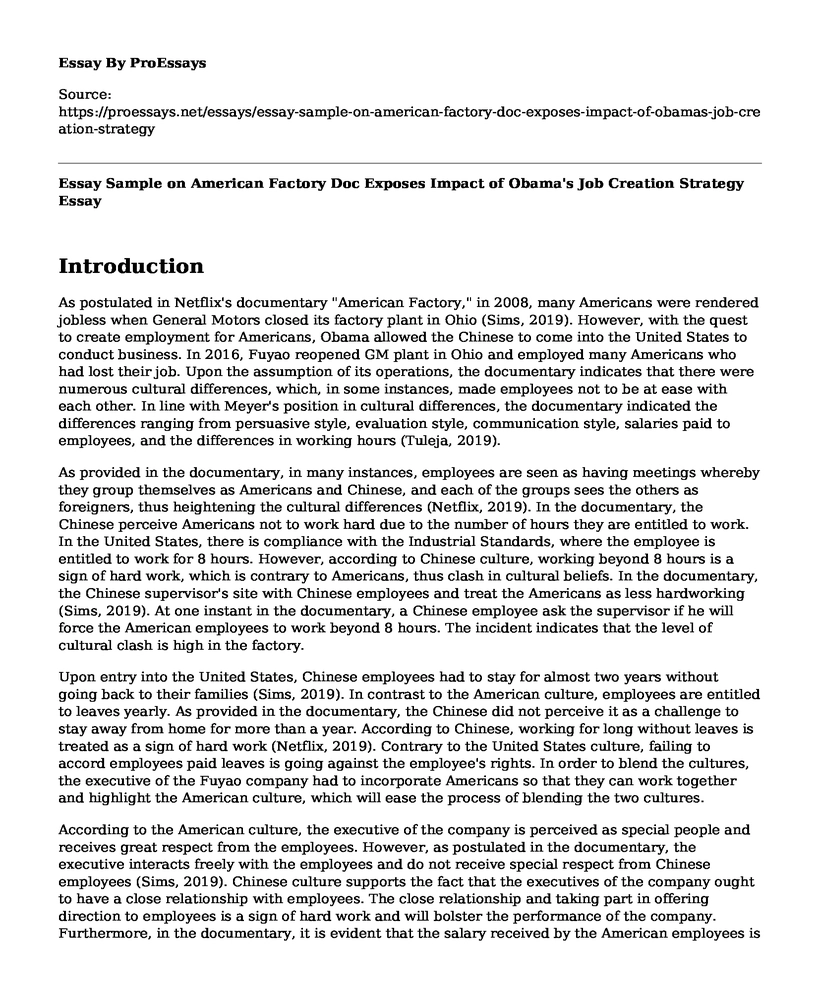Introduction
As postulated in Netflix's documentary "American Factory," in 2008, many Americans were rendered jobless when General Motors closed its factory plant in Ohio (Sims, 2019). However, with the quest to create employment for Americans, Obama allowed the Chinese to come into the United States to conduct business. In 2016, Fuyao reopened GM plant in Ohio and employed many Americans who had lost their job. Upon the assumption of its operations, the documentary indicates that there were numerous cultural differences, which, in some instances, made employees not to be at ease with each other. In line with Meyer's position in cultural differences, the documentary indicated the differences ranging from persuasive style, evaluation style, communication style, salaries paid to employees, and the differences in working hours (Tuleja, 2019).
As provided in the documentary, in many instances, employees are seen as having meetings whereby they group themselves as Americans and Chinese, and each of the groups sees the others as foreigners, thus heightening the cultural differences (Netflix, 2019). In the documentary, the Chinese perceive Americans not to work hard due to the number of hours they are entitled to work. In the United States, there is compliance with the Industrial Standards, where the employee is entitled to work for 8 hours. However, according to Chinese culture, working beyond 8 hours is a sign of hard work, which is contrary to Americans, thus clash in cultural beliefs. In the documentary, the Chinese supervisor's site with Chinese employees and treat the Americans as less hardworking (Sims, 2019). At one instant in the documentary, a Chinese employee ask the supervisor if he will force the American employees to work beyond 8 hours. The incident indicates that the level of cultural clash is high in the factory.
Upon entry into the United States, Chinese employees had to stay for almost two years without going back to their families (Sims, 2019). In contrast to the American culture, employees are entitled to leaves yearly. As provided in the documentary, the Chinese did not perceive it as a challenge to stay away from home for more than a year. According to Chinese, working for long without leaves is treated as a sign of hard work (Netflix, 2019). Contrary to the United States culture, failing to accord employees paid leaves is going against the employee's rights. In order to blend the cultures, the executive of the Fuyao company had to incorporate Americans so that they can work together and highlight the American culture, which will ease the process of blending the two cultures.
According to the American culture, the executive of the company is perceived as special people and receives great respect from the employees. However, as postulated in the documentary, the executive interacts freely with the employees and do not receive special respect from Chinese employees (Sims, 2019). Chinese culture supports the fact that the executives of the company ought to have a close relationship with employees. The close relationship and taking part in offering direction to employees is a sign of hard work and will bolster the performance of the company. Furthermore, in the documentary, it is evident that the salary received by the American employees is half the salary they used to receive when working for GM plant (Netflix, 2019). American culture dictates the amount paid to the employees, depending on the working profession. Contrary to this, the Chinese culture mode salary decision is based on the work output, and the executives also influence the amount to be paid as salary.
Conclusion
To sum up, setting up of the Fuyao Company served as an indicator of existing cultural differences in different countries. China's working environment has been shaped by its unique culture. Upon opening business operations in America, Fuyao brought its employees from China, which signified the introduction of new cultures in the working environment. The differences heightened to an extend that employees had no sound relationship. Inquest to avert the evident differences, the executive had to employ American supervisors who would later assist in blending the two rival cultures.
References
Netflix. (2019). American Factory [Video]. Retrieved 4 April 2020.
Sims, D. (2019). The Atlantic. American Factory Grapples with The Notion Of Freedom. Retrieved 4 April 2020, from https://www.theatlantic.com/entertainment/archive/2019/08/american-factory-review-julia-reichert-steven-bognar/597067/.
Tuleja, E. (2019). The University of Notre Dame. Understanding The 5 Dimensions of Culture with Dr. Elizabeth Tuleja. Retrieved 4 April 2020, from https://www.notredameonline.com/resources/intercultural-management/exploring-the-five-dimensions-of-culture/.
Cite this page
Essay Sample on American Factory Doc Exposes Impact of Obama's Job Creation Strategy. (2023, May 02). Retrieved from https://proessays.net/essays/essay-sample-on-american-factory-doc-exposes-impact-of-obamas-job-creation-strategy
If you are the original author of this essay and no longer wish to have it published on the ProEssays website, please click below to request its removal:
- Composer Style Report
- Analysis of the Movie Selma - Essay Sample
- Essay Example on 5 Steps of Writing Development: Prewriting, Drafting, Revising, Editing and Publishing
- Essay Sample on African & Asian Art: Impact on Modern Art Development
- John Donne's Contradictions Essay Example
- Massachusetts State House: A Study in Architectural Contrasts
- Fashion Companies Lack Clear Ethical Standards: What Does Sustainability Mean? - Essay Sample







